 I know it gets confusing but this list is a bit different from the Calde-not list from a couple days ago. The reason is simple. While the Calde-not list looks primarily at books with illustrations so distinguished they could easily win major illustration awards if given half a chance, this is list is more for those books that may not blow you away on a first glance, but that make our publishing landscape richer for their very existence. I was inordinately pleased after I read each and every one of these books. They’re a little peculiar, distinctly different from what you’ll find in the American market, and altogether remarkable.
I know it gets confusing but this list is a bit different from the Calde-not list from a couple days ago. The reason is simple. While the Calde-not list looks primarily at books with illustrations so distinguished they could easily win major illustration awards if given half a chance, this is list is more for those books that may not blow you away on a first glance, but that make our publishing landscape richer for their very existence. I was inordinately pleased after I read each and every one of these books. They’re a little peculiar, distinctly different from what you’ll find in the American market, and altogether remarkable.
2016 International Imports for Kids
Picture Books
Chirri & Chirra by Yuki Kaneko

Sweet and dreamlike, this Japanese import has a light and sweetness to it that will simultaneously make it deeply beloved in a few select homes, while also not drawing so much attention to itself that it ever becomes much more than a cult hit in the States. Do yourself a favor and discover it. It’s the kind of book you want to influence the dreams of your children with.
Cry, Heart, But Never Break by Glenn Ringtved, ill. By Charlotte Pardi
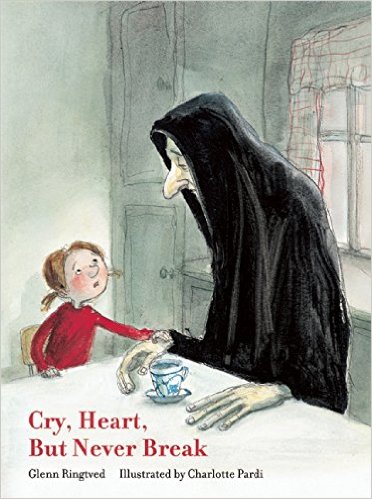
This Danish import just reminds us that when it comes to poetic picture books about death, American just don’t deal very well. Our death books tend to either be straightforward guides (here’s what to expect, etc.) or complete and utter fanciful metaphors. This book feels like it’s both fable and straightforward talk. A rare thing.
The Day I Became a Bird by Ingrid Chabbert, ill. Guridi

Kirkus didn’t get it. SLJ did. In this story a boy falls in love with a bird-loving girl. To get her attention he constructs an elaborate bird costume. Make of that what you will.
Don’t Cross the Line! by Bernardo P. Caravalho, ill. Isavel Martins

Portugal! And an interesting book at that. This one combines the interactive qualities of something like Don’t Let the Pigeon Drive the Bus or Press Here with a political statement about thwarting unjust authority. This book may get a bit more play in the coming years.
Look Up by Jung Jin-Ho

I love this one since it confronts and rearranges the reading experience and expectations of children. Add in the fact that it stars a girl in a wheelchair (who is not solely defined as a person from that chair) and you’ve got a golden book on your hands.
My Baby Crocodile by Gaetan Doremus
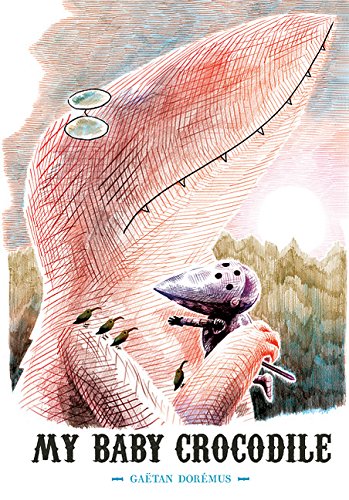
Funny story. I cannot read this book without setting it to the tune of “My Funny Valentine”. I suspect that this is because the two phrases share the same number of syllables more than anything else, but maybe it also has to do with the strange nature of love celebrated in this book. The story is between a near-sighted crocodile that “adopts” a knight, thinking he’s a baby croc. It’s odd and sweet and strange and funny. Memorable too.
A Promise Is a Promise by Knister, ill. Eve Tharlet

I found this one interesting perhaps because of the deep-seated feeling of betrayal our hero suffers in the course of things. It’s a very childlike understanding of an impossible promise and I like how it’s handled. A book that belies its cutesy cover.
Undercover by Bastien Contraire
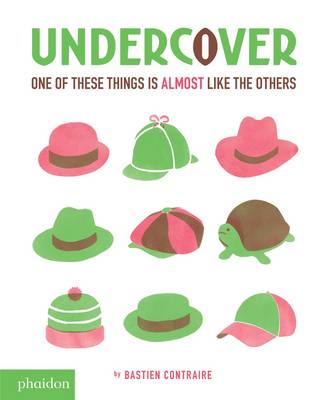
I absolutely adore this book. It’s a story where you have to spot the thing that doesn’t match. Contraire, living up to his name, doesn’t make it easy on you, though. The cover alone should be enough to prove that to you.
What Color Is the Wind? By Anne Herbauts
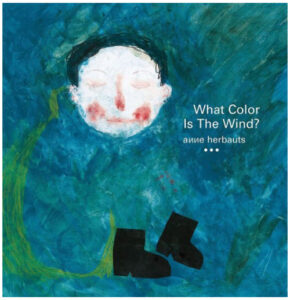
I’ve already reviewed it but if you somehow missed mention of this marvelous books about blindness and tactile response, now’s the time. You won’t find anything else like it on the market today.
Why Am I Here? by Constance Orbeck-Nilssen, ill. Akin Duzakin

Big questions for little brains. I like this one a lot. Lemur or not lemur.
Middle Grade
The Birth of Kitaro by Shigeru Mizuki

Honestly the backmatter explaining the entire history of the yokai in Japanese history and literature is some of the most fascinating stuff here. In a way, this book reads like what would have happened if Quasimodo turned into a superhero rather than a bell fantastic. I loved the peculiar (to me) nature of the storylines, the characters, and particularly the creatures.
The Heartless Troll by Oyvind Torseter
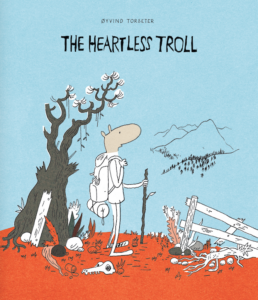
The troll is, without a doubt, one of the most horrific renderings I’ve seen in a children’s book in a long time. Which is to say – it’s awesome! Definitely hand this to older kids, but appreciate it on your own when you get a chance. As graphic novels go, there are few things to compare it to.
Under Earth / Under Water by Aleksandra Mizielinska and Daniel Mizielinski
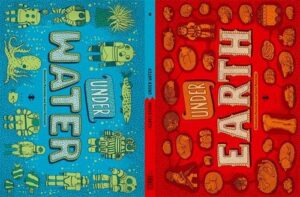
This Polish import is fantastic. There was a book of maps that came out from this couple previously. I’m not as big a fan of those, but what I am a fan of is learning about all that goes on below. Good times.
Misc
And just a quick shout-out to the Candied Plums titles that aren’t online yet. These are the real deal. I just adore them:
- Little Rabbit’s Questions by Dayong Gan, translated by Helen Wang (978194529270 – www.candiedplums.com)
- Picking Turnips by Xu Zhou, translated by Adam Lanphier (9781945295263 – www.candiedplums.com)
- Who Wants Candied Hawberries? by Dongni Bao, ill. Di Wu, translated by Adam Lanphier
Interested in the other lists of the month? Here’s the schedule so that you can keep checking back:
December 1 – Board Books
December 2 – Board Book Adaptations
December 3 – Nursery Rhymes
December 4 – Picture Book Readalouds
December 5 – Rhyming Picture Books
December 6 – Alphabet Books
December 7 – Funny Picture Books
December 8 – Calde-Nots
December 9 – Picture Book Reprints
December 10 – Math Picture Books
December 11 – Bilingual Books
December 12 – International Imports
December 13 – Books with a Message
December 14 – Fabulous Photography
December 15 – Fairy Tales / Folktales
December 16 – Oddest Books of the Year
December 17 – Older Picture Books
December 18 – Easy Books
December 19 – Early Chapter Books
December 20 – Graphic Novels
December 21 – Poetry
December 22 – Fictionalized Nonfiction
December 23 – American History
December 24 – Science & Nature Books
December 25 – Transcendent Holiday Titles
December 26 – Unique Biographies
December 27 – Nonfiction Picture Books
December 28 – Nonfiction Chapter Books
December 29 – Novel Reprints
December 30 – Novels
December 31 – Picture Books

 What Color Is the Wind?
What Color Is the Wind?
By Anne Herbauts
Translated by Claudia Zoe Bedrick
Enchanted Lion Books
$19.95
ISBN: 978-1-59270-221-3
Ages 5 and up
On shelves now
I’m going to have a hard time of it when my kids grow up. When I had them I swore up, down and sideways that I wouldn’t turn into the kind of blogger that declares that a book is good or bad, based solely on the whims of my impertinent offspring. For the most part, I’ve kept that promise. I review picture books outside of their influence, though I’m always interested in their opinions. Indeed, these opinions, and the sharp eyes that inform them, are sometimes not what I’d expect at all. So while I’ve never changed my opinion from liking a book to not liking it just because it didn’t suit my own particular kids’ tastes, I have admittedly found a new appreciation for other books when the children were able to spot things that I did not. What Color Is the Wind? is a pretty good example of this. I read the book at work, liked it fine, and brought it home for a possible review. My daughter then picked it up and proceeded to pretty much school me on what it contained, front to finish. Had I noticed the Braille on the cover? No. Did I see that the main character’s eyes are closed the whole time? No. How about the tactile pages? Did you notice that you can feel almost all of them? No. For a book that may look to some readers as too elegant and sophisticated to count as a favored bedtime story, think again. In this book Anne Herbauts proves beyond a shadow of a doubt that a distinct European style is engaging to American children when their parents give it half a chance. Particularly when tactile elements are involved.
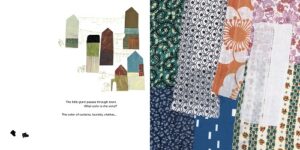 “We can’t see the wind, / we hear what it brings. / We can’t hear the wind, / we see what it brings.” The book begins with a question. A boy, his eyes closed, walks behind the cutout of a house. “What color is the wind? asks the little giant.” As he walks along, various plants, birds, animals, and inanimate objects offer answers. A wolf says the wind’s color is “the dark smell of the forest” while a window disagrees and says it’s “the color of time.” Everything that answers the little giant has a different feel on the page. The stream feels like consecutive ripples emanating from a dropped pebble, the roots of an apple tree like long, thin rivulets. At last the little giant encounters something that he senses is enormous. He asks his question and an enormous giant replies, “It is everything at once. This whole book.” He flips the book’s pages with his thumb so that they fly, and you the reader do the same, feeling the wind the book is capable of producing with its thick, lustrous pages. The color of the wind. The wind of this book.
“We can’t see the wind, / we hear what it brings. / We can’t hear the wind, / we see what it brings.” The book begins with a question. A boy, his eyes closed, walks behind the cutout of a house. “What color is the wind? asks the little giant.” As he walks along, various plants, birds, animals, and inanimate objects offer answers. A wolf says the wind’s color is “the dark smell of the forest” while a window disagrees and says it’s “the color of time.” Everything that answers the little giant has a different feel on the page. The stream feels like consecutive ripples emanating from a dropped pebble, the roots of an apple tree like long, thin rivulets. At last the little giant encounters something that he senses is enormous. He asks his question and an enormous giant replies, “It is everything at once. This whole book.” He flips the book’s pages with his thumb so that they fly, and you the reader do the same, feeling the wind the book is capable of producing with its thick, lustrous pages. The color of the wind. The wind of this book.
The Kirkus review journal said that this book was, “ ‘The blind men and the elephant’ reworked into a Zen koan” and then proceeded to recommend it for 9-11 year-olds and adults. I’m fairly certain I disagree with almost every part of that. Now here’s the funny part. I didn’t read this review before I read the book. I also didn’t read the press release that was sent to me with it. When I read a book I like to be surprised by it in some way. This is usually a good thing, but once in a while I can be a bit dense and miss the bigger picture. As I mentioned before, I completely missed the fact that this book was an answer to a blind child who had asked Anne Herbauts the titular question. I just thought it was cool that the book was so much fun to touch. Embossing, debossing, die-cuts, lamination, and all kinds of surfaces give the book the elements that make it really pop. As I read it in the lunchroom at work, my co-workers would peer over my shoulders to coo at what they saw. All well and good, but would a kid be interested too? Kirkus says they’d have to be at least nine to grasp its subtleties.
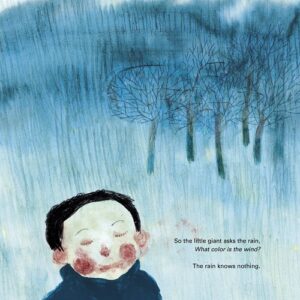 Obviously my 5-year-old daughter likes the book but she’s just one kid. She is not a representative for her species (so to speak). That said, this book just drills home the advantage that physical books have over their electronic counterparts: the sensation of touch. Play with a screen all day if you like, but you will never be able to move your fingers over these raised dots of rain or the rough bark of a tree’s trunk. As children become more immersed in the electronic, they become more enamored of tactile books. The sensation of paper on skin has yet to be replicated by our smooth as silk screens. And this will prove true with kids on the younger end of the scale. I’ll agree with Kirkus about the adult designation, though. When I worked for New York Public Library there was a group of special needs adults that would come in that were in need of tactile picture books. We would be asked if we had any on hand that we could hand over to them in some way. There were a few, but our holdings were pretty limited (though I do remember a particularly keen tactile version of The Very Hungry Caterpillar that proved to be a big hit). Those kids would have loved this book, but children of all ages, and all abilities, would feel the same way about it. Kids are never too old for tactile picture books. As such, you could use this book with Kindergartners as well as fifth graders. Little kids will like the fun pictures. Older kids may be inspired by the words as well.
Obviously my 5-year-old daughter likes the book but she’s just one kid. She is not a representative for her species (so to speak). That said, this book just drills home the advantage that physical books have over their electronic counterparts: the sensation of touch. Play with a screen all day if you like, but you will never be able to move your fingers over these raised dots of rain or the rough bark of a tree’s trunk. As children become more immersed in the electronic, they become more enamored of tactile books. The sensation of paper on skin has yet to be replicated by our smooth as silk screens. And this will prove true with kids on the younger end of the scale. I’ll agree with Kirkus about the adult designation, though. When I worked for New York Public Library there was a group of special needs adults that would come in that were in need of tactile picture books. We would be asked if we had any on hand that we could hand over to them in some way. There were a few, but our holdings were pretty limited (though I do remember a particularly keen tactile version of The Very Hungry Caterpillar that proved to be a big hit). Those kids would have loved this book, but children of all ages, and all abilities, would feel the same way about it. Kids are never too old for tactile picture books. As such, you could use this book with Kindergartners as well as fifth graders. Little kids will like the fun pictures. Older kids may be inspired by the words as well.
“Mom,” said my daughter as we went down the stairs for her post-reading, pre-brushing, nighttime snack. “Mom, you know the wind doesn’t have a color, right?” My child is a bit of a literalist. She’s the kid who knew early on that magic wasn’t real and once told me at the age of three that, “If ‘please’ is a magic word, it doesn’t exist.” So to read an entire book, based on the premise of seeing a color that couldn’t possibly be real, was a stretch for her. Remember, we read this entire book without really catching on that the little giant was blind. I countered that it was poetry, really. Colors were just as much about what they looked like as what they felt like. I asked her what blue made her feel, and red. Then I applied that to the emotions we feel about with the wind, which wasn’t really an analogy that held much water, but she was game to hear me out. “It’s poetry”, I said again. “Words that make you feel something when you read them.” So, as she had her snack, she had me read her some poetry. We’ve been reading poetry with her snack every night since. So for all that the book could be seen to be a straightforward picture book, to me it’s as much an introduction to poetry as anything else.
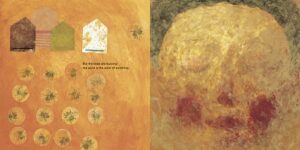
As for the art, I’ll admit that the combination of the style of art, the image on the cover, and the fact that the book is softcover and not hardcover (a cost-saving measure for what must be a very expensive title for Enchanted Lion Books to publish) did not immediately appeal to me. There’s no note to explain what the medium is and if I were to guess I’d say we were looking at crayons, mixed media, thick paints, colored pencils, ink blots, pen-and-inks, and more. Ironically, I really began to gravitate to the art when the little giant wasn’t stealing my focus. Nothing is intricately detailed, except perhaps the anatomy of honeybees or the raised and bumpy parts of the book. At the same time, for a book that celebrates touch, poetry, and physical sensation, the colors are often bright and lush. Whether it’s the blue watercolors of rain over trees or the hot orange that emanates from the page like a sun, Herbauts is simultaneously rendering illustrations obsolete with the unique format of What Color is the Wind? and celebrating their visual extremes.
I tend to give positive reviews to books that exceed my expectations. That’s just the nature of my occupation. And while I do believe that there are elements to this book that could be clearer or that there must have been a book jacket choice they could have chosen that was more appealing than the one you see here, otherwise I think this little book is a bit of a wonder. Deeply appealing to children of all ages, to say nothing of the adults out there, with so many uses, and so many applications. It reminds me of the old picture books by Bruno Munari that weren’t afraid to try new things with the picture book format. To get a little crazy. I don’t think we’ll suddenly see a big tactile picture book craze sweep the nation or anything, but maybe this book will inspire just one other publisher to try something a little different and to take a risk. Could be worth it. There’s nothing else like this book out there today. More’s the pity.
On shelves now.
Source: Final edition sent from publisher for review.
Like This? Then Try:
Professional Reviews:
Misc: A deeper look at some of the art over at Seven Impossible Things Before Breakfast

 Dwarf Nose
Dwarf Nose
By Wilhelm Hauff
Illustrated by Lisbeth Zwerger
Translated by Anthea Bell
Minedition
$19.99
ISBN: 97898888341139
Ages 8-12
On shelves April 1st
It seems so funny to me that for all that our culture loves and adores fairytales, scant attention is paid to the ones that can rightfully be called both awesome and obscure. There is a perception out there that there are only so many fairytales out there that people really need to know. But for every Cinderella or Sleeping Beauty you run into, there’s a Tatterhood or Riquet with the Tuft lurking on the sidelines. Thirty or forty years ago you’d sometimes see these books given a life of their own front and center with imaginative picture book retellings. No longer. Folktales and fairytales are widely viewed by book publishers as a dying breed. A great gaping hole exists, and into it the smaller publishers of the world have sought to fulfill this need. Generally speaking they do a very good job of bringing world folktales to the American marketplace. Obscure European fairytales, however, are rare beasts. How thrilled I was then to discover the republication of Wilhelm Hauff and Lisbeth Zwerger’s Dwarf Nose. Originally released in America in 1995 by North-South books, the book has long been out-of-print. Now the publisher minedition has brought it back and what a beauty it is. Strange and sad and oddly uplifting, this tale has all the trappings of the fairytales you know and love, but somehow remains entirely unexpected just the same.
For there once was a boy who lived with his two adoring parents. His father was a cobbler and his mother sold vegetables and herbs in the market. One day the boy was assisting his mother when a very strange old woman came to them and starting digging her dirty old hands through their wares. Incensed, the boy insulted the old woman, which as you may imagine didn’t go down very well. When the boy is made to help carry the woman’s purchases back to her home he is turned almost immediately into a squirrel and made to work for seven years in her kitchen. After that time he awakes, as if in a dream, only to find seven years have passed and his body has been transformed. Now he has no neck to speak of, a short frame, a hunched back, and a extraordinarily long nose. Sad that his parents refuse to acknowledge him as their son, he sets forth to become the king’s cook. And all would have gone without incident had he not picked up that enchanted goose in the market one day. Written in 1827 this tale is famous in Germany but remains relatively obscure in the United States today.
 I go back and forth when I consider why this fairytale isn’t all that famous to Americans. There are a variety of reasons. There are some depressing elements to it (kid is unrecognizable to parents, loses seven years of his life, etc.) sure. There aren’t any beautiful princesses (except possibly the goose). The bad guy doesn’t even appear in the second act. Still, it’s the peculiarities that give it its flavor. We’ve heard of plenty of stories where the heroes are transformed by the villains, but how many villains give those same heroes a useful occupation in the process? It’s Dwarf Nose’s practicalities that are so interesting, as are the nitty gritty elements of the tale. I love the use of herbs particularly. Whether the story is talking about Sneezewell or Bellyheal, you get the distinct feeling that you’re listening to someone who knows what they’re talking about. Plus there are tiny rodent servants. That’s a plus.
I go back and forth when I consider why this fairytale isn’t all that famous to Americans. There are a variety of reasons. There are some depressing elements to it (kid is unrecognizable to parents, loses seven years of his life, etc.) sure. There aren’t any beautiful princesses (except possibly the goose). The bad guy doesn’t even appear in the second act. Still, it’s the peculiarities that give it its flavor. We’ve heard of plenty of stories where the heroes are transformed by the villains, but how many villains give those same heroes a useful occupation in the process? It’s Dwarf Nose’s practicalities that are so interesting, as are the nitty gritty elements of the tale. I love the use of herbs particularly. Whether the story is talking about Sneezewell or Bellyheal, you get the distinct feeling that you’re listening to someone who knows what they’re talking about. Plus there are tiny rodent servants. That’s a plus.
We like it when our fairytales give us nice clear-cut morals. Be clever, be kind, be good. This may be another reason why Dwarf Nose never really took off in the States. At first glance one would assume that the moral would be about not judging by appearances. Dwarf Nose’s parents cannot comprehend that their beautiful boy is now ugly, and so they throw him out. He gets a job as a chef but does not search out a remedy until the goose he rescues gives him some hope. I was fully prepared for him to remain under his spell for the rest of his life without regrets, but of course that doesn’t happen. He’s restored to his previous beauty, he returns to his parents who welcome him with open arms, and he doesn’t even marry the goose girl. Hauff ends with a brief mention of a silly war that occurred thanks to Dwarf Nose’s disappearance ending with the sentence, “Small causes, as we see, often have great consequences, and this is the story of Dwarf Nose.” That right there would be your moral then. Not an admonishment to avoid judging the outward appearance of a thing (though Dwarf Nose’s talents drill that one home pretty clearly) but instead that a little thing can lead to a great big thing.
 When this version of Dwarf Nose was originally released in the States in 1994 the reviews were puzzled by its length. Booklist said it was “somewhat verbose to modern listeners” and School Library Journal noted the “grotesque tenor of the book”. Fascinatingly this is not the only incarnation of this tale you might find in America. In 1960 Doris Orgel translated a version of “Dwarf Long-Nose” which was subsequently illustrated by Maurice Sendak. The School Library Journal review of Zwerger’s version in 1994 suggested that the Sendak book was infinitely more kid-friendly than hers. I think that’s true to a certain extent. You get a lot more pictures with the Sendak and the book itself is a much smaller format. While Zwerger excels in infinitely beautiful watercolors, Sendak’s pen and inks with just the slightest hint of orange for color are almost cartoonish in comparison. What I would argue then is that the intended age of the audience is different. Sure the text is remarkably similar, but in Zwerger’s hands this becomes a fairytale for kids comfortable with Narnia and Hogwarts. I remember as a tween sitting down with my family’s copy of World Tales by Idries Shah as well as other collected fairytales. Whether a readaloud for a fourth grade class, an individual tale for the kid obsessed with the fantastical, or bedtime reading for older ages, Dwarf Nose doesn’t go for the easy audience, but it does go for an existing one.
When this version of Dwarf Nose was originally released in the States in 1994 the reviews were puzzled by its length. Booklist said it was “somewhat verbose to modern listeners” and School Library Journal noted the “grotesque tenor of the book”. Fascinatingly this is not the only incarnation of this tale you might find in America. In 1960 Doris Orgel translated a version of “Dwarf Long-Nose” which was subsequently illustrated by Maurice Sendak. The School Library Journal review of Zwerger’s version in 1994 suggested that the Sendak book was infinitely more kid-friendly than hers. I think that’s true to a certain extent. You get a lot more pictures with the Sendak and the book itself is a much smaller format. While Zwerger excels in infinitely beautiful watercolors, Sendak’s pen and inks with just the slightest hint of orange for color are almost cartoonish in comparison. What I would argue then is that the intended age of the audience is different. Sure the text is remarkably similar, but in Zwerger’s hands this becomes a fairytale for kids comfortable with Narnia and Hogwarts. I remember as a tween sitting down with my family’s copy of World Tales by Idries Shah as well as other collected fairytales. Whether a readaloud for a fourth grade class, an individual tale for the kid obsessed with the fantastical, or bedtime reading for older ages, Dwarf Nose doesn’t go for the easy audience, but it does go for an existing one.
Lisbeth Zwerger is a fascinating illustrator with worldwide acclaim everywhere except, perhaps, America. It’s not that her art feels too “foreign” for U.S. palates, necessarily. I suspect that as with the concerns with the length of Dwarf Nose, Zwerger’s art is usually seen as too interstitial for this amount of text. We want more art! More Zwerger! I’ve read a fair number of her books over the years, so I was unprepared for some of the more surreal elements of this one. In one example the witch Herbwise is described as tottering in a peculiar fashion. “…it was as if she had wheels on her legs, and might tumble over any moment and fall flat on her face on the paving stones.” For this, Zwerger takes Hauff literally. Her witch is more puppet than woman, with legs like bicycle wheels and a face like a Venetian plague doctor. We have the slightly unnerving sensation that the book we are reading is, in fact, a performance put on for our enjoyment. That’s not a bad thing, but it is unexpected.
 When Zwerger’s Dwarf Nose came out in 1994 it was entering a market where folktales were on the outs. Still, libraries bought it widely. A search on WorldCat reveals that more than 500 libraries currently house in on their shelves after all these years. And while folktale sections of children’s rooms do have a tendency to fall into disuse, it is possible that the book has been reaching its audience consistently over the years. It may even be time for an upgrade. Though it won’t slot neatly into our general understanding of what a fairytale consists of, Dwarf Nose will find its home with like-minded fellows. Oddly touching.
When Zwerger’s Dwarf Nose came out in 1994 it was entering a market where folktales were on the outs. Still, libraries bought it widely. A search on WorldCat reveals that more than 500 libraries currently house in on their shelves after all these years. And while folktale sections of children’s rooms do have a tendency to fall into disuse, it is possible that the book has been reaching its audience consistently over the years. It may even be time for an upgrade. Though it won’t slot neatly into our general understanding of what a fairytale consists of, Dwarf Nose will find its home with like-minded fellows. Oddly touching.
On shelves April 1st.
Source: Galley sent from publisher for review.
Misc: Check out this fantastic review of the same book by 32 pages.

 I know it gets confusing but this list is a bit different from the Calde-not list from a couple days ago. The reason is simple. While the Calde-not list looks primarily at books with illustrations so distinguished they could easily win major illustration awards if given half a chance, this is list is more for those books that may not blow you away on a first glance, but that make our publishing landscape richer for their very existence. I was inordinately pleased after I read each and every one of these books. They’re a little peculiar, distinctly different from what you’ll find in the American market, and altogether remarkable.
I know it gets confusing but this list is a bit different from the Calde-not list from a couple days ago. The reason is simple. While the Calde-not list looks primarily at books with illustrations so distinguished they could easily win major illustration awards if given half a chance, this is list is more for those books that may not blow you away on a first glance, but that make our publishing landscape richer for their very existence. I was inordinately pleased after I read each and every one of these books. They’re a little peculiar, distinctly different from what you’ll find in the American market, and altogether remarkable.






















I’m actually delighted that you sometimes use your children as readers. Every now and then I read a bunch of reviews for a book that adults are enchanted by–maybe the illustrations remind them of books when they were younger, or a particular moral is being taught, or the artist is particularly sophisticated and original…I order the book, read it to children, and receive a universal, “Huh?”
Of course there are books that really only work for a few kids, but the universal “Huh?”–where not one hand goes up, asking to check it out–always makes me wish I had my money back. If I had my way, every picture book would be taken to a school or day-care center and tried on kids before it’s published.
Agreed. And it’s been a real blow to my reviews, in a way, that I don’t have daily interactions with large groups of children anymore. In lieu of that I had to make a couple of my own. Still, two is not a representative sample so I hold myself back on using them too too often.